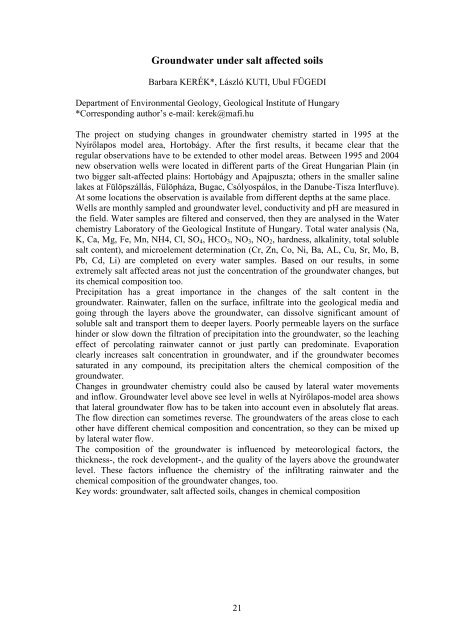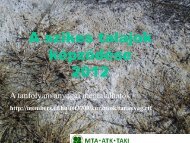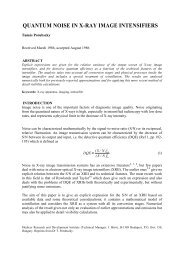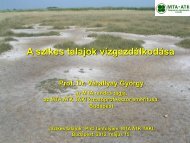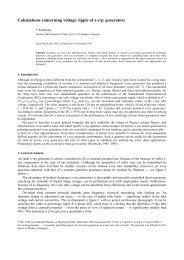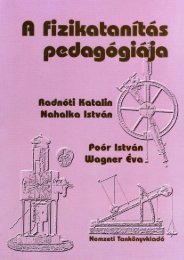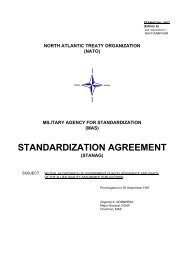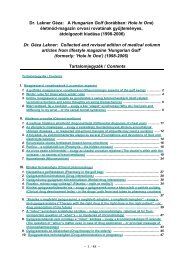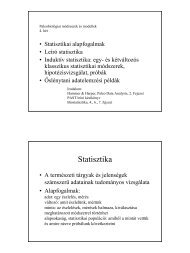Abstract form
Abstract form
Abstract form
Create successful ePaper yourself
Turn your PDF publications into a flip-book with our unique Google optimized e-Paper software.
Groundwater under salt affected soils<br />
Barbara KERÉK*, László KUTI, Ubul FÜGEDI<br />
Department of Environmental Geology, Geological Institute of Hungary<br />
*Corresponding author’s e-mail: kerek@mafi.hu<br />
The project on studying changes in groundwater chemistry started in 1995 at the<br />
Nyírőlapos model area, Hortobágy. After the first results, it became clear that the<br />
regular observations have to be extended to other model areas. Between 1995 and 2004<br />
new observation wells were located in different parts of the Great Hungarian Plain (in<br />
two bigger salt-affected plains: Hortobágy and Apajpuszta; others in the smaller saline<br />
lakes at Fülöpszállás, Fülöpháza, Bugac, Csólyospálos, in the Danube-Tisza Interfluve).<br />
At some locations the observation is available from different depths at the same place.<br />
Wells are monthly sampled and groundwater level, conductivity and pH are measured in<br />
the field. Water samples are filtered and conserved, then they are analysed in the Water<br />
chemistry Laboratory of the Geological Institute of Hungary. Total water analysis (Na,<br />
K, Ca, Mg, Fe, Mn, NH4, Cl, SO 4 , HCO 3 , NO 3 , NO 2 , hardness, alkalinity, total soluble<br />
salt content), and microelement determination (Cr, Zn, Co, Ni, Ba, AL, Cu, Sr, Mo, B,<br />
Pb, Cd, Li) are completed on every water samples. Based on our results, in some<br />
extremely salt affected areas not just the concentration of the groundwater changes, but<br />
its chemical composition too.<br />
Precipitation has a great importance in the changes of the salt content in the<br />
groundwater. Rainwater, fallen on the surface, infiltrate into the geological media and<br />
going through the layers above the groundwater, can dissolve significant amount of<br />
soluble salt and transport them to deeper layers. Poorly permeable layers on the surface<br />
hinder or slow down the filtration of precipitation into the groundwater, so the leaching<br />
effect of percolating rainwater cannot or just partly can predominate. Evaporation<br />
clearly increases salt concentration in groundwater, and if the groundwater becomes<br />
saturated in any compound, its precipitation alters the chemical composition of the<br />
groundwater.<br />
Changes in groundwater chemistry could also be caused by lateral water movements<br />
and inflow. Groundwater level above see level in wells at Nyírőlapos-model area shows<br />
that lateral groundwater flow has to be taken into account even in absolutely flat areas.<br />
The flow direction can sometimes reverse. The groundwaters of the areas close to each<br />
other have different chemical composition and concentration, so they can be mixed up<br />
by lateral water flow.<br />
The composition of the groundwater is influenced by meteorological factors, the<br />
thickness-, the rock development-, and the quality of the layers above the groundwater<br />
level. These factors influence the chemistry of the infiltrating rainwater and the<br />
chemical composition of the groundwater changes, too.<br />
Key words: groundwater, salt affected soils, changes in chemical composition<br />
21


